Bathtub coating with liquid acrylic: we renovate our own bathtubs
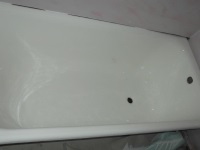
In the course of use, each piece of interior wear and tear, gradually acquiring more and more damage. And the bathtub is no exception to this. Over time, its coating wears out, which affects not only the appearance, but also the properties of this product. However, the condition of the bathtub is affected not only by time, but also by various other circumstances, such as the material and conditions of use.
Many people have repeatedly wondered how to bring an old bathtub back to its original appearance. You can simply replace the product, but in this case, you will have to face a lot of possible difficulties. Quite often when replacing the bathtub, it is necessary to replace the bathroom and the finish completely, and this will definitely cause a lot of financial costs.
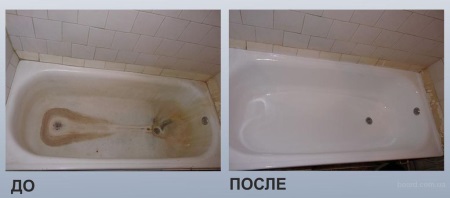
In order to avoid complications, there are several modern bathtub refinishing technologies available today. The most commonly used technologies are bathtub-to-bathtub inserts and the application of a new enamel coating. To apply a new coating to the bathtub, liquid acrylic is used, which makes The technology is called "liquid acrylic bathtub restoration". In order to carry out the restoration of the bathtub of this technology you will need acrylic enamel.
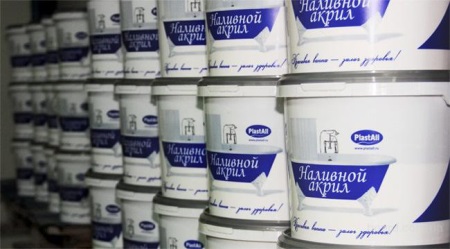
Advantages of the material
Compared with other materials used for the restoration of bathroom coverings, acrylic has a number of advantages. Let's consider them in more detail.
- High indicators of wear resistance and durability. Acrylic bath coating can stay in operation for up to fifteen years. Analogues of this coating can not last that long.
- Virtually no smell.. Liquid acrylic is almost odorless. Such a property of this coating allows you to carry out work on the restoration of the bathroom without the use of respiratory protection.
- Uniform mixing of the substance. When mixing the base and hardener, which are the components of liquid acrylic, a homogeneous mass is obtained, which avoids the uneven surface coverage that occurs when using liquid acrylic analogues.
- The absence of stains during use. The process of bathroom exploitation after restoration will not be accompanied by the appearance of spots on the surface.
- High homogeneity of the material. This property allows you to avoid air and bubbles in the enamel, which has not yet hardened to the end. For this reason, the number of tools used in the restoration is reduced, and an even, glossy finish is guaranteed.
- Short drying time. On average, liquid acrylic cures within thirty-six hours, providing an even, smooth finish. When using analogues with a shorter drying time, defective areas of the coating may appear.
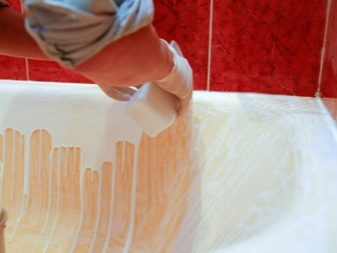
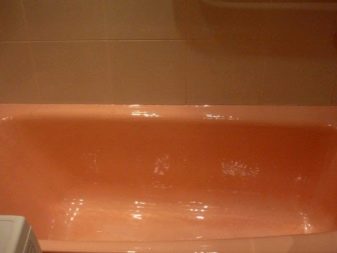
Restoration technology
When using liquid acrylic to restore the surface of the bathtub does not require a lot of time, effort and money. Today, pouring bath enamel using liquid acrylic is a fairly inexpensive and effective technology for the renewal of the quality characteristics of the surface of the bathtub.
The pouring method of applying enamel - economical, its application does not require a large amount of material. In addition, the resulting coating shows greater resistance to chemically active substances that can aggressively affect the renewed surface.
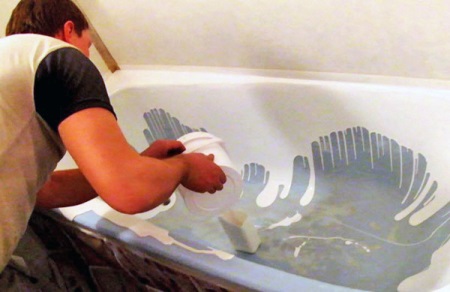
The technology consists in the fact that the material is applied by pouring method after preliminary preparation of the surface of the bath. The process can be performed independently, spending a minimum of money and time, which is the reason for the popularity of this technology.
Steps of work in the self-levelling restoration
You can do the bathtub restoration with liquid acrylic yourself. However, for this you need to follow a clear sequence of steps.
The necessary tools for work:
- respirator
- spatula
- sponges
- gloves
- Drill or grinder with an emery board.
Stages of work:
- Preparation of the surface. Before applying acrylic, it is necessary to prepare the original surface. To do this, you must first remove the old coating. Apply for this, abrasive stones, a drill or a grinder with a sandpaper nozzle. After the old coating is completely removed and its remaining particles washed off with warm water, the surface should be degreased. The preparation is completed by dialing hot water in the bathtub for about 10 minutes.
- Acrylic Preparation. The liquid acrylic used in bathtub restoration is prepared by mixing the base and hardener provided. In order to make a ready-to-use, solution, you need to thoroughly mix the components, according to the instructions, stirring them to the stage of a homogeneous mass of milky white color.
- Application of the mixture. When the solution is ready for use, it should be gradually poured into the bathroom, covering its entire surface. At the same time, you should start with the upper parts of the bath, passing along the perimeter. Particular attention should be paid to the bottom - it must be clearly formed before the material hardens. Correction of the surface is carried out with a rubber spatula, and the excess acrylic, if any, can be washed away in the drainage hole.

Watch the following video, where you will see in detail the entire process of covering the bath with liquid acrylic.
How to prepare the mixture?
As mentioned above, the bathtub coating mixture is made by mixing the two components together. Initially, you must carefully stir the base, which is an acrylic semi-finished product, and then gradually add to it the second component - the hardener, while carefully stirring to obtain a homogeneous mass to ensure an even coating of the surface of the tub.
Please note that a poorly mixed solution can not only cover the surface with a non-uniform layer, but also have a negative impact on the performance of the acrylic coating of the bath obtained.
If it is necessary to give the mixture a certain color, after obtaining a homogeneous mass of liquid acrylic, a tint is added. The amount of tint depends on how saturated shade you want to get as a result of coverage.
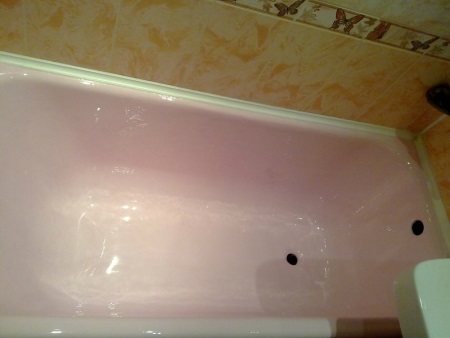
When the mixture is obtained, it is necessary to withstand a certain time, which depends on the temperature in the bathroom. For example, if the temperature in the room exceeds 30 degrees, the mixture can be applied after five to seven minutes, and at 20 degrees the exposure time is 15-20 minutes. After soaking, you can apply the mixture to the prepared surface of the bathroom.
Consumption of time and materials
Materials for bath restoration are consumed in proportion to the size of the bathtub. For example, a bath that is 1,5 m long requires 3,5 kg of materials, while restoring a bath that is 1,7 m long will require 4 kg of acrylic.
On average, it takes from two to four hours to carry out this procedure, taking into account the preliminary preparation of the surface. The process of applying liquid acrylic on the bath takes no more than one hour, the rest of the time will be occupied by preparatory procedures (cleaning and degreasing the bath).
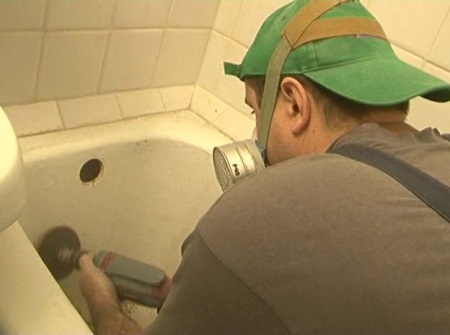
Observance of safety measures
During the work on the restoration of the bathtub, it is necessary to observe safety measures. For example, when preparing a surface for restoration, you must protect your respiratory tract and hands by using a respirator and gloves. A respirator may also be used when applying the mixture to the bathtub.
Tips when restoring a bathtub using pouring technology
When using liquid acrylic for bathtub restoration, take care to ensure that the work surface is cleaned, degreased and dried. This applies not only to the tub itself, but also to the tile or other surface that may be between the tub and the wall.
Also, if there is a need to cover part of the wall with the compound as well, ensure that the surface is as horizontal as possible. A new dry sponge or a piece of foam can be used to remove scraped bits of grout.
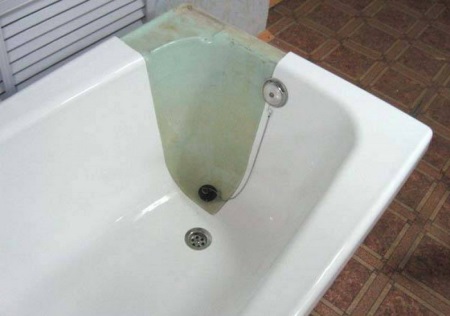
When drying the surface, it is best to use a regular hair dryer rather than a construction dryer. This will be safer for you and provide better conditions for the restoration. It is also recommended that the floor around the bathroom be lined with newspaper or PVC sheeting, as it is possible to contaminate the floor surface in the process. Vertical parts of the walls in contact with the surface are protected from contamination - masking tape.
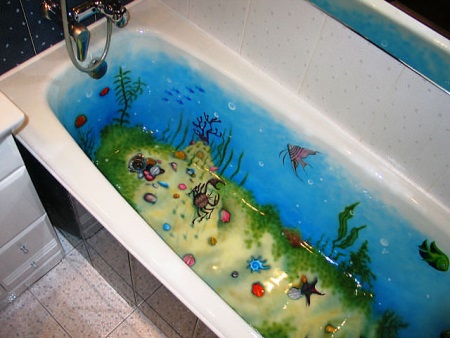
It is not recommended to dilute the bath enameling mixture with other chemicals, for example, solvent- the resulting layer will be thin and of poor quality, which will reduce the performance characteristics of the resulting bathroom coating.





It turns out that everything is not so complicated.